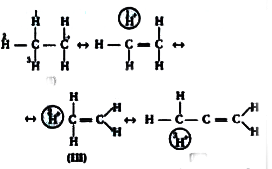Explain hyperconjugation or no bond resonance with example
Like resonance hyperconjugation also increases stability. In which without writing the bond of C−H of alkyle group, different structures are represented. Definition: ..It involves delocalisation of σ electrons of C-H bond of an alkyl group directly attached to an atom of unsaturated system or to an atom with an unshared p-orbital.
(a) Hyperconjugation effect in CH3+CH2 (ethyl cation) and its structure: In this CH3+CH2, the positively charge carbon atom has an empty p-orbital one of the C-H bonds of the methyl group can align in the plane of this empty p-orbital and the electrons constituting the C-H bond in plane with this p-obital can then be delocalised into the empty p-orbital

In such arrangement, hydrogen of alkyle group is other than H+ bond. The hyperconjugation structure of CH3+CH2 are as under

All the three hydrogen of CH3,1(H,2Hand3H becomes H+1 in structure (I) (II),(III) in these, there is no bond with H+. e no σ bond.
The positive charge (+) displace and delocalised by these structure and the stability of cation is increase.
(b) Relative comparisons of different alkyle cation: Because of the positive (+) charge of carbon, if no of alkyle group attach with the carbon increases then interaction in hyperconjugation is increases so, displacement of positive (+) charge increases hence, stability of carbocation increases
CH3−CH3+∣C∣CH3>(CH3)2+CH>CH3+CH2>+CH3← Stability of carbocation ↑ as ←
(c ) Hyperconjugation in alkene: Alkene e.g. in propene displacement of π electron in propene.

Orbital diagram showing hyperconjugation in propene. There are various ways of looking at the hyperconjugative effect. One of the way is to reagrd C-H bond as possessing partial ionic character due to resonance. The hyperconjugation (no bond) resonance structure of propene are as under
H−H∣C∣H−H∣C=H∣C−H↔H−H∣CH+=H∣C−H∣C..–––−H↔
H+H∣C∣H=H∣C−H∣C..–––−H↔
H−H+C∣H=H∣C−H∣C..–––−H
Topper's Solved these Questions
- ORGANIC CHEMISTRY SOME BASIC PRINCIPLES AND TECHNIQUESBook:KUMAR PRAKASHANChapter:ORGANIC CHEMISTRY SOME BASIC PRINCIPLES AND TECHNIQUESExercise:Section -A(Methods of Purification of Organic Compounds)
Explore 44 Videos
- ORGANIC CHEMISTRY SOME BASIC PRINCIPLES AND TECHNIQUESBook:KUMAR PRAKASHANChapter:ORGANIC CHEMISTRY SOME BASIC PRINCIPLES AND TECHNIQUESExercise:Section -A (Qualitative Analysis of organic compounds)
Explore 12 Videos
- ORGANIC CHEMISTRY SOME BASIC PRINCIPLES AND TECHNIQUESBook:KUMAR PRAKASHANChapter:ORGANIC CHEMISTRY SOME BASIC PRINCIPLES AND TECHNIQUESExercise:Section A (Fundamental Concepts in Organic Reaction Mechanism
Explore 10 Videos
- HYDROGENBook:KUMAR PRAKASHANChapter:HYDROGENExercise:Section-D NCERT Exemplar (Long Answer)
Explore 8 Videos
- QUESTION ASKED IN JEE -2018Book:KUMAR PRAKASHANChapter:QUESTION ASKED IN JEE -2018Exercise:MCQ
Explore 10 Videos
Similar Questions
Hyperconjugation is defined as No bond resonance. The concept of hyperconjugation arose from the discovery of electron releasing pattern for alkyl groups. It involves σ electrons of C-H bond. Greater the number of C-H bond (α-hydrogen atom w.r.t. double bond) more will be hyperconjugative structures, more will be stability Heat of hydrogenation of alkene are affected by hyperconjugative effects.
Which of the following is incorrect hyperconjugative structure?
View SolutionHyperconjugation is defined as No bond resonance. The concept of hyperconjugation arose from the discovery of electron releasing pattern for alkyl groups. It involves σ electrons of C-H bond. Greater the number of C-H bond (α-hydrogen atom w.r.t. double bond) more will be hyperconjugative structures, more will be stability Heat of hydrogenation of alkene are affected by hyperconjugative effects.
Which of the following has highest heat of hydrogenation?
View Solution
Knowledge Check
Hyperconjugation is defined as No bond resonance. The concept of hyperconjugation arose from the discovery of electron releasing pattern for alkyl groups. It involves σ electrons of C-H bond. Greater the number of C-H bond (α-hydrogen atom w.r.t. double bond) more will be hyperconjugative structures, more will be stability Heat of hydrogenation of alkene are affected by hyperconjugative effects.
Which of the following is incorrect hyperconjugative structure?A B
B C
C D
D
Hyperconjugation is defined as No bond resonance. The concept of hyperconjugation arose from the discovery of electron releasing pattern for alkyl groups. It involves σ electrons of C-H bond. Greater the number of C-H bond (α-hydrogen atom w.r.t. double bond) more will be hyperconjugative structures, more will be stability Heat of hydrogenation of alkene are affected by hyperconjugative effects.
Which of the following has highest heat of hydrogenation?A B
B C
C D
D
Explain the formation of ionic bond with two examples.
View SolutionExplain the formation of ionic bond with two examples.
View SolutionFor the compound :
Give the number "1" for presence of resonance only,"2" for presence of resonance and hyperconjugation only,"3" for presence of resonance, hyperconjugation and inductive effect and "4" for presence of resonance hyperconjugation, inductive effect and electromeric effect.
View SolutionFor the compound

Give the number 1 for presence of resonance only, 2 for presence of resonance and hyperconjugation only, 3 for presence of resonance, hyperconjugation and inductive effect and 4 for presence of resonance hyperconjugation, inductive effect and electronic effect
View SolutionHyperconjugation (+H & -H Effect) -With Examples|Summary
View SolutionExplain the
Hyperconjugation effect is also termed as 'no bond resonance'.
View Solution
